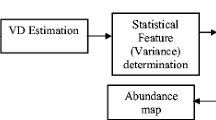Abstract
A new algorithm for decomposition of mixed pixels based on orthogonal bases of data space is proposed in this paper. It is a simplex-based method which extracts endmembers sequentially using computations of largest simplex volumes. At each searching step of this extraction algorithm, searching for the simplex with the largest volume is equivalent to searching for a new orthogonal basis which has the largest norm. The new endmember corresponds to the new basis with the largest norm. This algorithm runs very fast and can also avoid the dilemma in traditional simplex-based endmember extraction algorithms, such as N-FINDR, that it generally produces different sets of final endmembers if different initial conditions are used. Moreover, with this set of orthogonal bases, the proposed algorithm can also determine the proper number of endmembers and finish the unmixing of the original images which the traditional simplex-based algorithms cannot do by themselves. Experimental results of both artificial simulated images and practical remote sensing images demonstrate the algorithm proposed in this paper is a fast and accurate algorithm for the decomposition of mixed pixels.
Similar content being viewed by others
References
Chang C -I. Hyperspectral Imaging: Techniques for Spectral Detection and Classification. New York: Plenum, 2003
Xu J Y, Yang J, Peng Y N. A new approach to dual-band polarimetric radar remote sensing image classification. Sci China Ser F-Inf Sci, 2005, 48(6): 747–761
Ge Z R, Wang B, Zhang L M. Remote sensing image fusion based on Bayesian linear estimation. Sci China Ser F-Inf Sci, 2007, 50(2): 227–240
Boardman JW, Kruse F A, Green R O. Mapping target signatures via partial unmixing of AVIRIS data. In: Proc. Summ. JPL Airborne Earth Sci. Workshop, Pasadena, CA, 1995. 23–26
Craig M D. Minimum-volume transforms for remotely sensed data. IEEE Trans Geosci Remote Sens, 1994, 32(3): 542–552
Ifarraguerri A, Chang C -I. Multispectral and hyperspectral image analysis with convex cones. IEEE Trans Geosci Remote Sens, 1999, 37(2): 756–770
Winter M E. N-FINDR: An algorithm for fast autonomous spectral end-member determination in hyperspectral data. In: Proc. SPIE Conf. Imaging Spectrometry V, 1999. 266–275
Nascimento Jose M P, Bioucas Dias Jose M. Vertex component analysis: A fast algorithm to unmix hyperspectral data. IEEE Trans Geosci Remote Sens, 2005, 43(4): 898–910
Chang C -I, Wu C -C, Liu W M, et al. A new growing method for simplex-based endmember extraction algorithm. IEEE Trans Geosci Remote Sens, 2006, 44(10): 2804–2819
Harsanyi J C, Chang C -I. Hyperspectral image classification and dimensionality reduction: An orthogonal subspace projection approach. IEEE Trans Geosci Remote Sens, 1994, 32(4): 779–785
Plaza A, Chang C -I. Impact of initialization on design of end-member extraction algorithms. IEEE Trans Geosci Remote Sens, 2006, 44(11): 3397–3407
Shen W X. An Introduction to Simplex Theory (in Chinese). Changsha: Hunan Normal University Press, 2000
Green A A, Berman M, Switzer P, et al. A transformation for ordering multispectral data in terms of image quality with implications for noise removal. IEEE Trans Geosci Remote Sens, 1988, 26(1): 65–74
Chang C -I, Du Q. Estimation of number of spectrally distinct signal sources in hyperspectral imagery. IEEE Trans Geosci Remote Sens, 2004, 42(3): 608–619
Settle J J, Drake N A. Linear mixing and estimation of ground cover proportions. Int J Remote Sens, 1993, 14(6): 1159–1177
Heinz D C, Chang C -I. Fully constrained least squares linear spectral mixture analysis method for material quantification in hyperspectral imagery. IEEE Trans Geosci Remote Sens, 2001, 39(3): 529–545
Chang C -I, Ji B H. Weighted abundance-constrained linear spectral mixture analysis. IEEE Trans Geosci Remote Sens, 2006, 44(2): 378–388
Clark R N, Swayze G A, Gallagher A, et al. The US geological survey digital spectral library: Version 1: 0.2 to 0.3 microns. US Geol Surv, Open File Rep., 1993
Landgrebe D. Multispectral data analysis: A signal theory perspective. School of Electr. Comput. Eng., Purdue Univ., West Lafayette, IN, 1998
Author information
Authors and Affiliations
Corresponding author
Rights and permissions
About this article
Cite this article
Tao, X., Wang, B. & Zhang, L. A new approach based on orthogonal bases of data space to decomposition of mixed pixels for hyperspectral imagery. Sci. China Ser. F-Inf. Sci. 52, 843–857 (2009). https://doi.org/10.1007/s11432-009-0017-9
Received:
Accepted:
Published:
Issue Date:
DOI: https://doi.org/10.1007/s11432-009-0017-9




